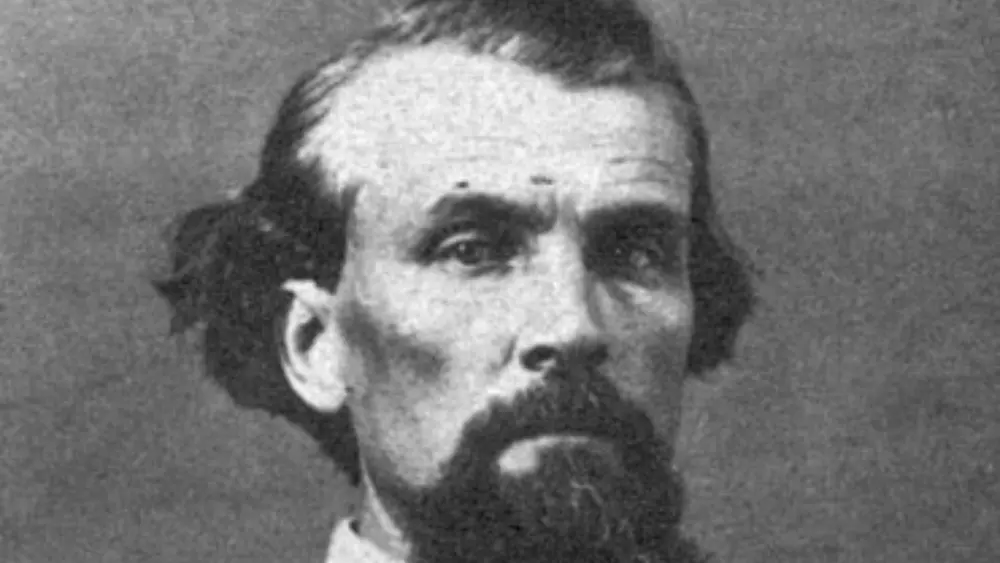Nathan Bedford Forrest, born on July 13, 1821, in Chapel Hill, Tennessee, was a prominent Confederate cavalry general during the American Civil War. Revered for his tactical brilliance and audacious leadership, Forrest earned a reputation as one of the most effective and controversial figures in the Confederate Army.
Early Life and Business Ventures
Nathan Bedford Forrest’s early life was rooted in modest beginnings. Born into a farming family, he had limited access to formal education. However, his life would take a different trajectory as he displayed an early knack for entrepreneurship and business acumen. In the years preceding the Civil War, Forrest achieved remarkable success as a cotton planter, slave trader, and businessman. His ventures amassed wealth, a pivotal moment, setting the stage for his role in a turbulent period in American history.
Forrest’s journey from a humble upbringing to becoming a prosperous plantation owner and entrepreneur highlights his adaptability and resourcefulness. His pre-war business success intertwined with his military career, shaping him into a notable, controversial Civil War-era figure.
Nathan Bedford Forrest: Civil War Service and Leadership
Forrest began as a private but swiftly rose to command due to his innate leadership qualities during the Civil War. His remarkable ascent through the ranks demonstrated his exceptional military prowess. Forrest excelled as a battlefield commander, especially in the cavalry, and was known for his aggressive and unconventional tactics during the Civil War. His audacious raids and rapid maneuvers earned him the enduring moniker of the “Wizard of the Saddle.”
Forrest’s vital Confederate contributions and unique leadership set him apart during the Civil War among his contemporaries. His leadership, inspiration, and innovative tactics posed a formidable challenge to Union forces during the entirety of the Civil War. His military feats secured his historical legacy, celebrated as a cavalry commander and controversial due to his Confederate affiliation.
The Fort Pillow Massacre Controversy
A contentious episode in Nathan Bedford Forrest’s legacy is the 1864 Battle of Fort Pillow, sparking debates and discussions. This battle is particularly notorious due to the events that transpired during and after the conflict. In this battle, many Union soldiers, including African American troops, were killed while trying to surrender, sparking controversy. The incident prompted massacre allegations against Forrest’s Confederate forces for flouting war rules and killing surrendering soldiers indiscriminately. Differing historical accounts of Fort Pillow fuel complex and contentious aspects of Forrest’s legacy, subject to ongoing scrutiny and debate.
Fort Pillow’s controversy highlights the Civil War’s divisive and morally troubling aspects, casting a lasting shadow on Forrest’s historical reputation. Debates over Fort Pillow persist, showcasing the Civil War’s moral complexity despite efforts to emphasize his military prowess and leadership.
Nathan Bedford Forrest: Tactics and Strategy
Nathan Bedford Forrest’s prowess as a cavalry commander was characterized by his exceptional adaptability and tactical ingenuity. He possessed a remarkable ability to adjust his strategies to suit the ever-changing conditions of warfare during the Civil War. His tactical brilliance was especially evident in his mastery of hit-and-run raids, a style of warfare in which he excelled. By conducting lightning-fast maneuvers and disrupting enemy supply lines, Forrest consistently demonstrated his knack for catching adversaries off guard and achieving success on the battlefield.
Forrest’s audacious and innovative approach to warfare set him apart as a commander who was unafraid to take calculated risks. His ability to think on his feet and make rapid decisions under pressure contributed significantly to his military achievements. His reputation as a commander of great resourcefulness and adaptability remains a key facet of his legacy, showcasing his contributions to the Confederate cause during one of the most unruly periods in American history.
Post-War Activities and Reconciliation
After the Civil War, Nathan Bedford Forrest’s life transformed as he worked to rebuild the war-torn South. Despite previous military success, financial difficulties pushed him into various business ventures to restore his wealth. During this time, Forrest’s perspective on the nation’s future shifted. He sought reconciliation between the North and South, acknowledging the need for healing and unity in a divided country. His efforts included advocating for civil rights for African Americans, a stance uncommon among former Confederate leaders.
Forrest’s post-war actions reveal the intricate facets of his legacy. While a formidable Confederate cavalry commander during the war, his evolving views on reconciliation and civil rights showcase the complexities of his character and the challenging era in American history he navigated. His later unity efforts and civil rights advocacy continue to be subjects of historical discussion and interpretation.

Nathan Bedford Forrest: Legacy and Controversy
Nathan Bedford Forrest’s legacy is a deeply contentious and polarizing topic in American history. His undeniable military prowess and leadership during the Civil War have earned him recognition as a formidable Confederate commander. However, his legacy is marred by his association with the slave trade, a deeply troubling and morally reprehensible aspect of his life. Additionally, the Battle of Fort Pillow, with its allegations of a massacre of surrendering Union troops, has cast a long shadow over his historical reputation.
In contemporary times, the debate over Forrest’s legacy remains heated, particularly in discussions about the appropriateness of statues and memorials dedicated to Confederate figures like him. These discussions touch upon broader themes of historical interpretation, the reconciliation of a painful past, and the ongoing challenges related to racism in American society. Nathan Bedford Forrest’s legacy serves as a stark reminder of the complexities and controversies surrounding the commemoration of historical figures from the Civil War era, reflecting the enduring divisions and debates in the United States over issues of race, memory, and historical remembrance.










